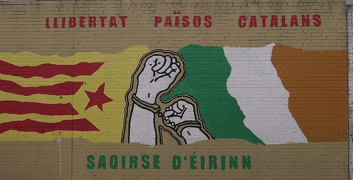Gareth Jones Asst. Int’l Editor
At some point in middle or high school you were likely, hopefully, made to look at a map of the world. You have probably forgotten most of it beyond the basic shape of things, (the African rhino and the massive sprawl of frozen rock that is Russia) and what, with 200 nation-states and countless territories you’ll never even meet anyone from, as well you probably should forget. But it’s interesting to look at one every now and then, to see how things are going, and depending on how long ago high school was, it may look quite different.
In the last five years the world has welcomed a few new nations, or specifically not welcomed them depending on who you ask. As you read this at least ten groups, mostly ethnic and nationalistic, are pleading, arguing, coercing, bribing and bombing their way towards the newest place on that list.
The ones you have heard of, surprisingly, are the ones farthest away from achieving actual independence. ETA, the Basque separatist group who bombed Madrid trains in the 80’s and 90’s, have more or less failed. In fact, their only lasting effect on the international community is the fact that because of them, Spain will never recognize the independence of a splinter group, for fear of encouraging their own separatists to become militant once again.
You will notice that to this day they do not acknowledge Kosovo, who otherwise has 98 supporting UN member states, or Palestine, with 131. The other one you’ve heard of is the tiny “Russian Caucuses,” most notably Georgia (itself more or less a state) and North/South Ossetia. A few years ago they made international headlines when a group of rebels stormed a Russian occupied village and filmed themselves cutting off the heads of a bunch of young Russian soldiers.
Both of these potential secessionist groups cite financial woes as part of their reasons for wanting to leave, but a main reason they’ve not succeeded is because of the ambiguity behind any potential financial benefits from such a drastic move. Indeed, some hardcore Basque nationalists argue that staying attached to Spain while the European Union showers bailout money on them is better than breaking off and trying to fend for themselves. This economic uncertainty is the main factor behind all secessionists’ difficulties, going beyond just the most militant sects.
The newest nonviolent example of these groups is Scotland, who will vote for their independence from the United Kingdom in 2014. The debate on whether to secede is heated, and has recently blown up again following the United Kingdom’s loss of an AAA credit rating from the international watchdog of sorts, Moody, a blow that raised premiums on all of the UK government’s ability to borrow money.
The campaign to prevent an independent Scotland highlighted the UK’s then excellent credit rating and raised the valid point that a fledgling nation, regardless of economic standing would have a hard time reaching such a favorable rating. However, now that the UK has fallen from the world’s most elite borrowers (of which there are only 10-15, all Northern European except for Canada and Australia) this campaign tactic has lost a lot of power. Whether or not Scotland will secede remains to be seen of course, and with polls putting the yes to independence vote at roughly 32 percent, it’s still very much up in the air.
_________________________________
Dan Olson Journal Staff
Recently, people in regions of Spain and France, known as Catalonia, are pressing the Spanish and French governments for their own independence. As expected, there is much controversy associated with this movement from both the citizens of Madrid, Southern France, and even citizens in the Catalan region itself.
The belief that Catalonia should be its own independent nation dates back to the early twentieth century, and since then there have been strong feelings towards sovereignty. Last month, the new parliament of the region approved a new declaration stating that the nation is a sovereign entity, which then allows further steps towards its independence, as stated by the Huffington Post.
According to the Associated Press, “The declaration sets up a potential showdown with the central government in Madrid, which has said it will block any move toward Catalonian independence in the courts.”
With apparently so much determination and potential government backlash, it is expected that a vast majority of citizens living in the Catalan area would be supportive of the movement, especially since it has been in the air for decades; there is even a flag design created for a promising new country. However, according to a poll by the Huffington Post, only about half of the Spanish or French citizens living within the region known as Catalonia are fully supportive of the sovereignty.
And, while it may be argued that even when America was in the process of becoming an independent nation, not everyone was fully supportive; we certainly had advantages that those in Catalonia do not have. America occupied its own land, separated from the nation which owned it. All of the land spread across the Catalan region is occupied by both Spain and France. While location might not make a difference, if only half of the people living in that region want it to be its own country, living on land owned by two other countries will pose problems for Catalonian Independence activists.
With so much disagreement among governments, the Catalan region may exit the European Union as a result of their independence, which is where many Catalonian citizens are drawing the line. And, while its independence is imminent, whether or not the regions’ parliament will decide to withdraw from the EU is unclear. In fact, much of this controversy is unclear. Reasoning for a sudden push for independence is hard to come by. Could it be that because the exact reasons were established decades ago, now only the spirit and overall idea of the movement remains?














The Suffolk Journal • Mar 1, 2013 at 1:00 pm
[International] Secession movements in Europe: in or out?: http://t.co/TZWIpWkxo9